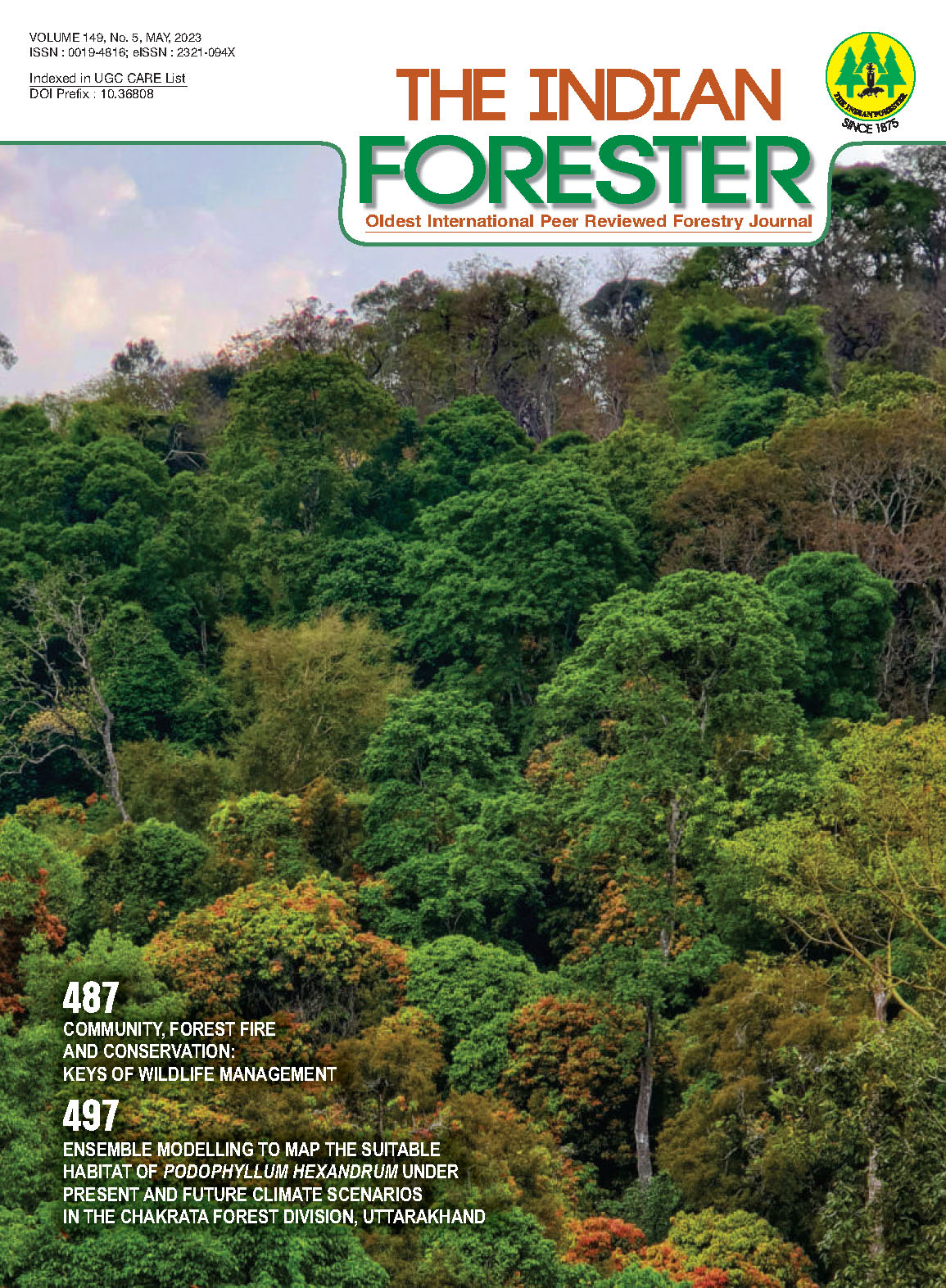Impact of Alternate Fuels on Domestic Fuelwood Consumption in Foot Hills of Western Himalayas
DOI:
https://doi.org/10.36808/if/2023/v149i5/168336Keywords:
Fuelwood, Alternate Fuels, Ganderbal, Jammu and Kashmir and Himalayas.Abstract
The present investigation “Impact of Alternate fuels on Fuelwood Consumption in foot hills of western Himalayas†was carried out, during the year 2019-2021 to investigate the impact of alternative domestic fuels on fuelwood consumption among the local people in Ganderbal district of Kashmir Himalayas. The sample of study area was drawn by multi-stage random sampling technique. The data were collected through personal interviews of respondents using well-structured pre-tested interview schedule and non-participant observations. The study revealed that liquefied Petroleum Gas (LPG), kerosene and electricity was the alternative fuels used by local people. With increase in consumption of alternate fuels, fuelwood consumption was found to decrease. Among the alternate fuel determinants LPG and electricity consumption had shown a negatively significant relationship with fuelwood consumption and other attributes such as kerosene consumption had shown non-significant relationship with fuelwood consumption. Regression analysis of alternate fuels impacting the domestic fuelwood consumption was carried out in the sample villages. The analysis of 't' values of regression co-efficient indicated that out of the three alternate fuel variables, LPG and electricity consumption, had significant contribution in influencing the fuelwood consumption.References
Eldirdiri F.E. and Adam Y.O. (2010). Can fuel switching from wood to liquefied petroleum gas reduce the deforestation in Sudan? Research journal of forestry, 4(4): 194-201.
Evans P.T. (1988). Designing agroforestry innovations to increase their adoptability: a case study from Paraguay. Journal of Rural Studies, 4: 45-55.
FAO (2009). Planted forests and second-generation biofuels. Planted Forests and Trees, Working Paper, FP/42E. Rome.
Heltberg R., Arndt T.C. and Sekhar N.U. (2000). Fuelwood consumption and forest degradation: A household model for domestic energy substitution in rural India. Institute of Economics, University of Copenhagen, Copenhagen, Denmark, 76(2): 213-232.
Kumar L., Aggarwal R.K. and Baweja P.K. (2015). A study on energy consumption pattern in developing areas of Western Himalayan State. Current World Environment , 10(3): 903-911.
Mukherjee N. (1993). Participatory Rural Appraisal: Methodology and Applications. Concept Publishing Company, Delhi.
Mushtaq T., Sood K.K., Raina N.S. (2014). Delineating key determinants of domestic fuelwood Consumption of rural households in Western Himalaya Policy Implications. Journal of Mountain Science, 11(1): 195-204.
Pandey D. (2002). Fuelwood studies in India-Myth and Reality. Centre for International Forestry Research, Indonesia, 72-74.
Parikh J.K. (1980). Energy systems and development. Constraints, Demand and Supply of Energy for Developing Regions, 13-16 .Oxford University Press, Delhi, India.
Rai S.N. and Chakrabarti S.K. (2001). Demand and supply of fuelwood and timber in India. Indian Forester, 127(3): 23-29.
Rao Y.S. (1985). Building success through people's participation. Journal of Unasylva, 37: 29-35.
Ray G.L. and Mondol S. (2004). Research methods in social sciences and extension education, Kalyani publishers, New Delhi, 66-76.
Saud T., Singh D.P., Mandal T.K., Gadi R., Pathak H., Saxena M., Sharma S.K., Gautam R., Mukherjee A. and Bhatnagar R.P. (2011). Spatial distribution of biomass consumption as energy in rural areas of the Indo-Gangetic plain. Biomass and Bioenergy, 35(2): 932-941.
Sharma L.R., Chand R. and Bhatti J.P. (1989). An analysis of farmers' dependence on forest for fuelwood, fodder and timber in Himachal Pradesh. Agricultural Situation in India, 44(5): 359-363.
Shwetha B.A., Kushalappa C.G. and Shruthy M.K.G. (2013). A study on fuelwood consumption pattern from coffee based agro-forestry systems in the Cauvery watershed region of Kodagu district, Karnataka. International Journal of Forestry and Crop Improvement, 4(1): 28-31.
Singha A.K., Talukdar R.K. and Singha J.K. (2006). Maintenance behaviour of forest resources by the people of forest villagers in Assam. Indian Journal of Forestry, 29(1): 47-54.
Sood R., Aggarwal R.K., Mahajan P.K., Bhardwaj S.K. and Sharma S. (2014). Estimation of domestic energy consumption and carbon emission in mid Himalayan region of Himachal Pradesh, India. Journal of Agriculture and Environmental Sciences, 3(1): 141-147.
Venkataramaiah P. (1990). Development of socio-economic status scale, Ph.D. Thesis, Department of Agricultural Extension, UAS, Bangalore.
Xiaohua W., Kunquan L., Hua L., Di B. and Jingru L. (2017). Research on China's rural household energy consumption-Household investigation of typical counties in 8 economic zones. Renewable andSustainableEnergyReviews,68:28-32.
Downloads
Downloads
Published
How to Cite
Issue
Section
License
Unless otherwise stated, copyright or similar rights in all materials presented on the site, including graphical images, are owned by Indian Forester.





